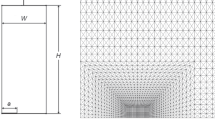Abstract
A three-dimensional, time-dependent computer program is used for the stress-strain analysis of elastic-plastic materials subjected to tensile loads. Several geometries are considered. The capabilities and advantages of this explicit finite difference computer program are demonstrated, and recommendations for future applications are made.
Résumé
Un programme de calcul à 3 dimensions et indépendant du temps a été utilisé pour l'analyse en tension-déformation des matériaux élasto-plastiques sujets à des contraintes et des tractions. On considère différents types de géométries. Les possibilités et les avantages que présente ce programme de calcul par différence finie explicite sont démontrés et l'on a fait des recommandations pour ses applications futures.
Similar content being viewed by others
References
M. L. Wilkins, R. E. Blum, E. Cronshagen and P. Crantham, A Method for Computer Stimulation of Problems in Solid Mechanics and Gas Dynamics in Three Dimensions and Time, Lawrence Livermore Laboratory Rept. UCRL-51524 (1974).
M. L. Wilkins, S. J. French and M. Sorem, Finite Difference Scheme for Calculating Problems in Three Space Dimensions and Time, Proc. Second International Conf. Numerical Methods in Fluid Dynamics, M. Holted., Lecture Notes in Physics, 8, Springer-Verlag, New York (1971) 30–33.
M. L. Wilkins, Calculation of Elastic-Plastic Flow, Methods in Computational Physics, B. Alder, S. Frenbach and M. Rotenbergeds., Academic Press, New York and London 3 (1964) 211.
Y. M. Chen, Numerical Computation of Dynamic Stress Intensity Factors by a Lagrangean Finite Difference Method (HEMP Code), Engineering Fracture Mechanics, 7 (1975) 653.
P. D. Hilton and G. C. Sih, Applications of the Finite Element Method to the Calculations of Stress Intensity Factors, Mechanics of Fracture I: Methods of Analysis and Solutions of Crack Problems, G. C. Sihed., Noordhoff International Publishing, Leyden, The Netherlands (1973) 426.
W. K. Wilson, Finite Element Methods for Elastic Bodies Containing Cracks, Mechanic of Fracture I: Methods of Analysis and Solutions of Crack Problems, G. C. Sihed., Noordhoff International Publishing, Leyden, The Netherlands (1973) 484.
G. Strang and G. J. Fix, An Analysis of the Finite Element Method, Prentice-Hall, Inc., Englewood Cliffs, N.J. (1973) 40.
E. L. Wilson, Solid SAP, Structural Engineering Laboratory, University of California, Berkeley, Rept. UC SESM 71–19 (1972).
A. S. Kobayashi, R. D. Cherepy, and W. C. Kinsel, Journal of Basic Engineering Transactions of the ASME, Series D., 86 (681) 1964.
A. E. Green and I. N. Sneddon, Proceedings of the Cambridge Philosophical Society, 46 (159) (1950).
N. Levy, P. V. Marcal, and J. R. Rice, Nuclear Engineering and Design, 17 (64) (1971).
T. K. Hellen and W. S. Backburn, The Calculation of Stress Intensity Factors in Two and Three Dimensions Using Finite Elements, Computational Fracture Mechanics, E. F. Rybicki and S. E. Benzley, ed., ASME (1975) 102–119.
G. R. Irwin, Journal of Applied Mechanics Transactions of ASME, 29 (651) (1962).
R. C. Shah and A. S. Kobayashi, Stress Intensity Factors for an Elliptical Crack Approaching the Surface of a Semi-Infinite Solid, The Surface Crack: Physical Problems and Computational Solutions, J. L. Swedlow, ed., presented at the Winter Annual Meeting of ASME, New York, N.Y. (1972).
R. J. Hartranft and G. C. Sih, Alternating Method Applied to Edge and Surface Crack Problems, Mechanics of Fracture I: Methods of Analysis and Solutions of Crack Problems, G. C. Sihed., Noordhoff International Publishing, Leyden, The Netherlands (1972) 179.
T. A. Cruse, Elastic Fracture Mechanics Analysis for 3-Dimensional Cracks, ASCE Preprint 2430, ASCE National Structural Engineering Conv., April 14–18, 1975.
F. W. Smith, A. S. Kobayashi, and A. F. Emery, Journal of Applied Mechanics Transactions of ASME, 34 (1967) 953.
R. W. Thresher and F. W. Smith, Journal of Applied Mechanics Transactions of ASME, 95 (1972) 195–200.
Author information
Authors and Affiliations
Rights and permissions
About this article
Cite this article
Chen, Y.M., Wilkins, M.L. Stress analysis of crack problems with a three-dimensional, time-dependent computer program. Int J Fract 12, 607–617 (1976). https://doi.org/10.1007/BF00034646
Received:
Revised:
Published:
Issue Date:
DOI: https://doi.org/10.1007/BF00034646




